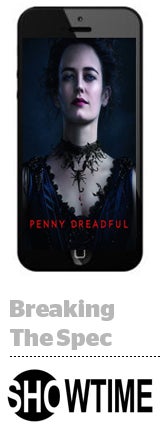 “Limited opportunities for creativity” – 44% of marketers surveyed by the IAB and research firm Ovum cite it as one of the key challenges they face when it comes to mobile advertising.
“Limited opportunities for creativity” – 44% of marketers surveyed by the IAB and research firm Ovum cite it as one of the key challenges they face when it comes to mobile advertising.
That may be the perception, but it’s not the reality, as Showtime demonstrated at the IAB’s Mobile Marketplace conference in New York City on Monday.
“We carved out special executions on our media plan with more interactivity,” said Ken Todd, VP of digital content syndication and mobile development at Showtime Networks. “Our mandate was to break through the spec in mobile advertising.”
That required collaboration between Showtime’s internal app development group, its digital creative and design teams and the brand managers in charge of each show.
Showtime chose a few tentpole executions to focus on, including SXSW in Austin. The network has been a title sponsor of SXSW’s official GO event app since 2013.
The first year Showtime sponsored the app, it was looking to create some sort of utility for users, Todd said.
To that end, Showtime pulled in real-time data from Foursquare and Twitter and integrated it with info from Google Maps to display trending locations around the festival and throughout the city of Austin.
In 2014, Showtime centered its efforts on the premiere of “Penny Dreadful,” which the network was planning to screen at SXSW that year. Showtime tapped into trending data again, this time marrying it with the concept of tarot card games, which played a prominent role in the show’s first episode.
An in-app unit formed the canvas for an interactive tarot game. Depending on which cards were chosen, users were presented with tips on what to do that day at SXSW. The information was also dayparted. People received suggestions on which sessions to hit during the day. At night, the game recommended bars and restaurants.
This year, Showtime took a more straightforward approach by capitalizing on every festival attendee’s least favorite thing to do – wait in interminable lines to get into popular sessions and battle public transportation to get around town. Showtime gave SXSW app users some free TV programming, including free episodes and other short-form content, to help entertain them while they waited.
“It was an entertainment experience, but it wasn’t just trailers for upcoming shows,” Todd said.
Showtime doesn’t just capitalize on external tentpole events, however.
For the launch of its action drama “Ray Donovan,” Showtime worked with Medialets to run a takeover of The New York Times website with edge-to-edge autoplay banners featuring interactive videos running within. Each frame of the video contained a hotspot so that when users tapped, the video would pause and bring up an overlay with more information on a particular character.
 To promote “The Affair,” Showtime worked with betaworks studio-owned Tapestry to create a tappable interstitial that enabled users to progressively advance through the ad – a kind of manual GIF. The unit ran across a variety of publishers, including Entertainment Weekly, People, Vogue and The New York Times.
To promote “The Affair,” Showtime worked with betaworks studio-owned Tapestry to create a tappable interstitial that enabled users to progressively advance through the ad – a kind of manual GIF. The unit ran across a variety of publishers, including Entertainment Weekly, People, Vogue and The New York Times.
The coup de grace was Showtime’s promotion for the fourth season of “Homeland,” a tactile video ad that would cause a user’s phone to shake when a bomb went off in the trailer.
“We want to capture as much interactivity in the unit itself as possible, without having people click through an ad to a different experience,” said Todd.
That’s the kind of mindset that Ned Newhouse, executive director of mobile and native at Condé Nast, likes to see. It’s time for a digital creative “reboot,” he said. Viewability is irrelevant without creativity.
“Creative wasn’t necessarily always spoken about, [but] it’s the linchpin of our success,” said Newhouse, who also serves as co-chair of the IAB’s tablet advertising committee. “If you buy an ad, it should be seen, but please make sure the ad you’re going to post is worth my time. We don’t have banner blindness – we have bad creative.”
And there’s no need for that, said Mihael Mikek, CEO and co-founder of mobile ad company Celtra. The industry gets it, Mikek said. According to recent recent from Celtra, 52% of media buyers are looking for better UX from new ad formats and 40% are looking to provide more native-like experiences.
“Everyone believes we need to go beyond the rectangles,” Mikek said. “Much of the focus over the last two years has been to find the right audience at the right price, how to do things more efficiently in terms of buying and selling – but the message is where the innovation will take place and it’s where the differentiation will be made.”
That said, the industry is far from having solved for mobile creative. Showtime’s got a sexy product and deep pockets, but as Saatchi & Saatchi lead creative technologist Steve Nowicki pointed out, there’s just isn’t enough innovative inventory available.
When the creative team at Saatchi looks at a banner ad sitting jammed onto the bottom of a page, they just shrug their shoulders and sigh.
“They say, ‘What am I going to do with this?’” Nowicki said. “I could throw a JPEG in there … but that’s it.”













